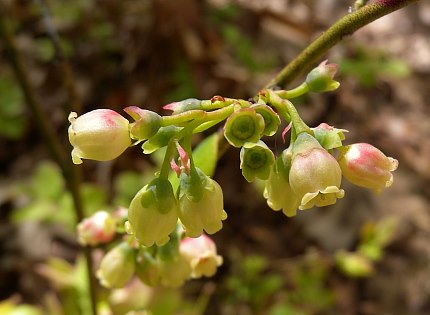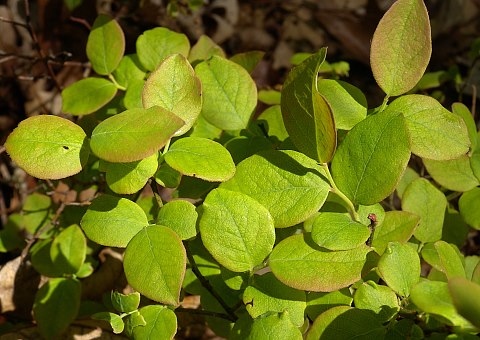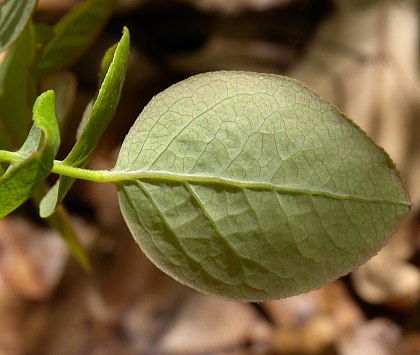Description: This is a deciduous shrub about ½-3' tall that branches occasionally. Young branches are initially green, but they later become yellowish green and more or less covered with small warty dots. Young branches are usually glabrous, but sometimes they are slightly pubescent. Older branches become woody and vary in color from red to yellowish brown; on the trunk and very old branches, the bark becomes shredded. Alternate leaves occur along new branches. The blades of these leaves are ¾-2¼" long and ½-1" across; they are oval, ovate, obovate, or broadly elliptic in shape, and their margins are smooth or minutely toothed toward the tips of the blades. The upper surface of the leaf blades is medium green or yellowish green and glabrous (sometimes with reddish tints in bright sunlight), while the lower surface is pale green, glabrous, and sometimes glaucous. Less often, the lower surface of the leaf blades may be slightly pubescent. The petioles are short and slender.

Raceme-like clusters of flowers develop from second-year branches. The pedicels of the flowers are light green and glabrous. Each flower (up to 1/3" or 8 mm. in length) is longer than it is wide, consisting of a tubular corolla with 5 tiny recurved lobes, a short light green calyx with 5 broad teeth, 10 inserted stamens, and a pistil with a single style. The corolla is somewhat constricted toward its outer rim and its exterior is greenish white, pink-tinted cream, or red. The blooming period occurs from late spring to early summer and lasts about 3 weeks. The flowers are replaced by globoid berries about ¼" across that are initially green, but they later become dark blue with a whitish bloom. The berries become mature during mid- to late summer; they are juicy and sweet, containing 8-20 tiny seeds that are less than 1.5 mm. in length. The woody root system is branched and shallow, forming underground runners that can produce clonal offsets. At favorable sites, colonies of clonal plants are often formed. The leaves become red to dark red during the autumn before they fall to the ground.

Cultivation:
The
preference is partial sun, mesic to dry conditions, and an acidic soil
containing sandy or rocky material.
Range & Habitat:
Hillside Blueberry is occasional in northern Illinois, southern
Illinois, and sandy areas along the Illinois River in central Illinois.
Elsewhere in the state, it is rare or absent (see Distribution
Map). Habitats include upland rocky forests, thinly wooded
bluffs and rocky hillsides, sandy forests and sandy savannas, openings
in sandy forests, sandstone cliffs and glades, sandy roadside
embankments, sandy ditches, and abandoned sandy fields. Hillside
Blueberry is often
found in fire-adapted habitats because it is able to resprout from its
underground runners. Dominant trees in these habitats are either oaks
or pines.

Faunal
Associations:
The flowers are cross-pollinated by honeybees, bumblebees, and Andrenid
bees. These bees suck nectar from the flowers and, to a lesser extent,
collect pollen. Various insects eat the leaves and other parts of
blueberries (Vaccinium spp.). These species include
the caterpillars of such butterflies as Callophrys henrici
(Henry's Elfin), Satyrium liparops strigosum (Striped Hairstreak), and Colias interior (Pink-edged Sulphur); also the caterpillars of such moths as Hemaris gracilis (Graceful
Clearwing), Sphinx canadensis (Canadian Sphinx), Acleris curvalana (Blueberry Leaftier), and Catocala andromedae (Andromeda Underwing). Other insect feeders of blueberries include Oberea myops
(Rhododendron Stem Borer), Melanoplus fasciatus
(Huckleberry Grasshopper), Dasineura cyanococci (Blueberry Bud Gall Midge), Rhagoletis mendax (Blueberry Fruitfly), Illinoia pepperi (Blueberry Aphid), Clastoptera saintcyri (Heath Spittlebug), Phenacoccus rubivorus (False Puto Mealybug), and Loxaulus vaccinii (Blueberry Stem Gall Wasp). The Insect Table has a more complete list of these species.
The edible berries are eaten by many upland gamebirds and songbirds
(see the Bird Table).
Mammals that eat the berries include the American Black Bear, American
Red Fox, Gray Fox, Striped Skunk, Fox Squirrel, Least Chipmunk,
Franklin's Ground Squirrel, White-Footed Mouse, Woodland Deer
Mouse, and Woodland Jumping Mouse (Martin et al., 1951/1961; Hamilton,
1941; Schmidt, 1931; Beeman & Pelton, 1980; Mosnier et al., 1951;
Romain et al., 2013; Noyce & Coy, 1990). The berries are also eaten
by Terrapene
carolina (Eastern Box Turtle) and Clemmys insculpta
(Wood Turtle); see Ernst et al. (1994). The leaves and twigs of blueberries are occasionally
browsed by White-Tailed Deer and the Cottontail Rabbit (Martin et al., 1951/1961; Haugen, 1942). Colonies of
Hillside Blueberry and other low-bush blueberries provide cover for
many small animals in upland areas.
Photographic Location:
An open sandy woodland near Bittersweet Farm in NW Ohio.

Comments: There is some variability in the shape of leaves, the hairiness of leaves and young stems, and the color of the flowers. As a result, different varieties of Hillside Blueberry have been described by some authors. In areas where their ranges overlap, this species is capable of hybridizing with the similar Vaccinium angustifolium (Northern Low-Bush Blueberry). This latter species tends to have more slender leaves than Hillside Blueberry, and they are usually more serrated along their margins. While the lower leaf surface of Hillside Blueberry is lighter (pale green) than the upper leaf surface, the lower and upper leaf surfaces of Northern Low-Bush Blueberry are about the same color (medium green). An obsolete scientific name of Hillside Blueberry is Vaccinium vacillans. Other common names of this species are Early Low-Bush Blueberry and Blue Ridge Blueberry.